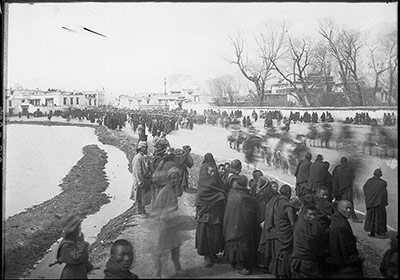
1998.285.429 (Glass negative)


1998.285.429 (Glass negative)

Rabden Lepcha
Sir Charles Bell
March 3rd 1921?
Lhasa
1998.285.429
120 x 163 mm
Negative glass plate gelatin , Negative Half Plate
Donated 1983
St Antony's College, Oxford.
Copy Neg
Sir Charles Bell's Mission to Lhasa 1920-21
Royal Central Asiatic Society
Rabden Lepcha?
H.400-310
BL.H.400-310
Manual Catalogues - Bell's List of Illustrations entry: "[No. of chapter] LXVI. [Subject of Chapter] Festivals [Subject of Illustration] H.400-310 (a) Lhasa en fete. After the Tor-gya festival."
Other Information - Setting: Despite Bell's caption, this image may be of the Chipgyu Chenmo procession when the Dalai Lama moved to his summer residence in the Norbu Lingka. The quality of the image may be explained by the conditions under which it was taken. At the Dalai Lama’s request Bell had some photographs taken of the procession by Rabden, but taking place in the early morning it meant that the light was too weak to produce good results [Sir Charles Bell's Diary Vol. IX, pp. 29-31]. However, Bell describes this as crowds watching a procession after the Torgya festival, in which case it would be dated to 3rd March 1921. In neither case would Bell himself have been at this spot to take the photographs [MS 23/02/2006]
For Citation use:
The Tibet Album.
"Procession in Lhasa"
05 Dec. 2006. The Pitt Rivers Museum.
<http://tibet.prm.ox.ac.uk/photo_1998.285.429.html>.
For more information about photographic usage or to order prints, please visit the The Pitt Rivers Museum.
© The Pitt Rivers Museum